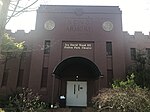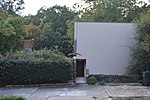Gregg Museum of Art & Design
North Carolina State University

The Gregg Museum of Art & Design is the art museum of North Carolina State University and is located near NC State's main campus in Raleigh, North Carolina. To current NC State chancellor Randy Woodson, the Gregg is "an opportunity to not only celebrate the arts and design at NC State, but to welcome the community onto our campus in a new way." The Gregg holds exhibitions, lectures, workshops, film screenings, and other educational activities; admission to the Gregg is free.
Excerpt from the Wikipedia article Gregg Museum of Art & Design (License: CC BY-SA 3.0, Authors, Images).Gregg Museum of Art & Design
Hillsborough Street, Raleigh Oberlin
Geographical coordinates (GPS) Address Nearby Places Show on map
Geographical coordinates (GPS)
| Latitude | Longitude |
|---|---|
| N 35.7855 ° | E -78.661294 ° |
Address
North Carolina State University
Hillsborough Street
27695 Raleigh, Oberlin
North Carolina, United States
Open on Google Maps










